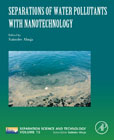
Separations of Water Pollutants with Nanotechnology, the latest volume in the Separation Science and Technology series, offers new solutions for remediating water pollution utilizing nanomaterials with separation methods. Current water purification methods are unsuitable, inconvenient or expensive, so there is a need for new and better processes and techniques. Nanomaterials can purify water by removing pollutants such as heavy metals, pathogens, organic compounds, inorganic compounds, pharmaceuticals, and chemicals of emerging concern. These can effectively replace membrane-based methods if the right expertise is developed-this book helps separation scientists do just that. Existing water treatment problems can be solved by applying a nanotechnology-based processes: antimicrobial nanotechnology, zero-valent iron nanoparticles, nanoadsorbents, nano-enhanced membranes, nanometal oxides, and nano photocatalysts. The current literature places emphasis on materials chemistry rather than the separation methods used for water purification. This new volume presents a collection of chapters that deal with remediation based on separation chemistry. Written by leaders in their respective fields from around the world and edited by Satinder Ahuja, a leading expert on water quality improvement Covers the environmental impact of anthropogenic nanoparticles and plant derived bionanomaterials, which are not contained in other books related to nanomaterials for water purification Illustrates key information visually wherever possible throughout the book, e.g. process diagrams in the nanomaterial synthesis and nanomembrane fabrication chapters, electron microscope images, and more INDICE: 1. Overview2. Detecting nanomaterials3. Assessing the environmental impact of anthropogenic nanoparticles4. A review of nanomaterials for water purification5. Association of nanoparticles with genetic materials 6. Enhancing water security7. Nanomembranes8. Inorganic nanoadsorbents9. Remediation of VOC10. Micro- and nanostructured cellulose-based scaffold for water purification11. Plant derived bionanomaterials and their applications12. Remediation of heavy metals13. Remediation of pharmaceuticals14. Remediation of pesticides15. Remediation of contaminants of emerging concern16. Photocatalytic degradation of antibiotics17. Sustainable nanotechnolgy
- ISBN: 978-0-323-90763-7
- Editorial: Elsevier
- Encuadernacion: Rústica
- Páginas: 314
- Fecha Publicación: 02/05/2022
- Nº Volúmenes: 1
- Idioma: Inglés
